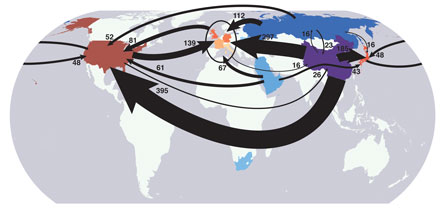Carbon dioxide: blame where blame is due?
Tracking the outsourcing of greenhouse gas emissions
SAN FRANCISCO — One all-too-familiar side effect of international trade is the outsourcing of jobs, or their movement from developed nations (where production costs are relatively high) to regions where a variety of costs are relatively low. But the geographic separation of production and consumption also has a less recognized, or at least a less frequently discussed, effect — the “outsourcing” of greenhouse gas emissions, says Steven J. Davis, a geochemist at the Carnegie Institution for Science in Stanford, Calif.

Recently, Davis and his Carnegie colleague Ken Caldeira analyzed economic data for 113 countries (or groups of countries such as the Middle East) and for 57 economic sectors. In their study, the researchers estimated the amount of each country’s or region’s homegrown carbon dioxide emissions (such as those associated with construction and agriculture) as well as the amount that could be attributed to transportable items such as wood, food and finished goods. For the year 2004, the last year for which detailed economic data are available, about 23 percent of carbon dioxide emissions worldwide were associated with the production of goods or services that crossed national or regional borders, Davis and Caldeira reported December 14 during the annual meeting of the American Geophysical Union.
Production of the goods and services consumed in the United States, the world’s largest consumer nation, generated a total of about 6.5 billion metric tons of carbon dioxide, the researchers estimate. But about 699 million tons, or just under 11 percent, of those greenhouse gas emissions were associated with goods imported to the United States from elsewhere. In Japan, almost 18 percent of the carbon dioxide emissions associated with goods consumed there were produced outside that nation. In some nations of Western Europe, between one-fifth and one-half of the CO2 emissions are outsourced, Davis notes.
At the other extreme, there’s China: About 22.5 percent of the CO2 emissions generated there are associated with goods and services that are exported and consumed elsewhere. In fact, more than three-quarters of those emissions were associated with goods or services consumed in the United States, the European Union, or Japan.
For developing countries such as Afghanistan, Bhutan or the nations in Central America and Africa, most of the outsourced emissions are associated with imported food, says Davis. But for developed nations, the outsourced emissions often are associated with electronics or other consumer goods.
Allocating the responsibility for carbon dioxide emissions to the final consumer of goods, rather than to the producer of those goods, is one way to attribute the burden of mitigating the climate-warming effects of those emissions, Davis and Caldeira say. Using such a formula would shift mitigation costs to the primary beneficiaries of those emissions — countries that also have the greatest ability to pay, the researchers note.






